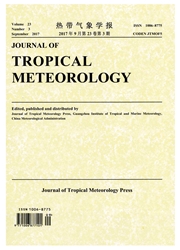

 中文摘要:
中文摘要:
Ice water content(IWC) plays important roles in weather and climate change.Determining the IWCs of cirrus clouds with millimeter-wavelength radar can be problematic due to influences of ice particle rotation on their backscattering cross sections.We here introduce models to describe the radiation patterns of six nonspherical particles of specific sizes.Simulations using HFSS software were applied to describe the differences resulting from different orientations and equivalent spheres.A double exponential function was used for fitting to describe the relationship between the particles’ maximum sizes and backscattering cross sections.The backscattering cross sections of nonspherical ice particles were computed by the method of moment,and those of the equivalent spherical particles were computed by Lorenz-Mie theory for three different orientations:fixed,horizontal,and random.Assuming that a mixture of nonspherical ice particles follows the B-H mixing model,the size distribution of cirrus particles obeys the exponential distribution measured by NASA in 2007.By computing the IWCs of cirrus clouds,which follows the above mentioned B-H model and exponential distribution,the radar reflectivity factors of nonspherical ice particles and equivalent spheres at three different orientations can be computed.Subsequently,the IWC results can be acquired by inputting the radar reflectivity variables into the well-known IWC-Z formula.The analysis described here demonstrates that when using the radar reflectivity Z,the orientation must be considered in order to determine the IWC.Using equivalent sphere theory,the derived IWCs underestimate the actual IWCs.These results are important for accurately retrieving the microphysical parameters of cirrus clouds.
 英文摘要:
英文摘要:
Ice water content (IWC) plays important roles in weather and climate change. Determining the IWCs of cirrus clouds with millimeter-wavelength radar can be problematic due to influences of ice particle rotation on their backscattering cross sections. We here introduce models to describe the radiation patterns of six nonspherical particles of specific sizes. Simulations using HFSS software were applied to describe the differences resulting from different orientations and equivalent spheres. A double exponential function was used for fitting to describe the relationship between the particles' maximum sizes and backscattering cross sections. The backscattering cross sections of nonspherical ice particles were computed by the method of moment, and those of the equivalent spherical particles were computed by Lorenz-Mie theory for three different orientations: fixed, horizontal, and random. Assuming that a mixture of nonspherical ice particles follows the B-H mixing model, the size distribution of cirrus particles obeys the exponential distribution measured by NASA in 2007. By computing the IWCs of cirrus clouds, which follows the above mentioned B-H model and exponential distribution, the radar reflectivity factors of nonspherical ice particles and equivalent spheres at three different orientations can be computed. Subsequently, the IWC results can be acquired by inputting the radar reflectivity variables into the well-known IWC-Z formula. The analysis described here demonstrates that when using the radar reflectivity Z, the orientation must be considered in order to determine the IWC. Using equivalent sphere theory, the derived IWCs underestimate the actual IWCs. These results are important for accurately retrieving the microphysical parameters of cirrus clouds.
 同期刊论文项目
同期刊论文项目
 同项目期刊论文
同项目期刊论文
 期刊信息
期刊信息
